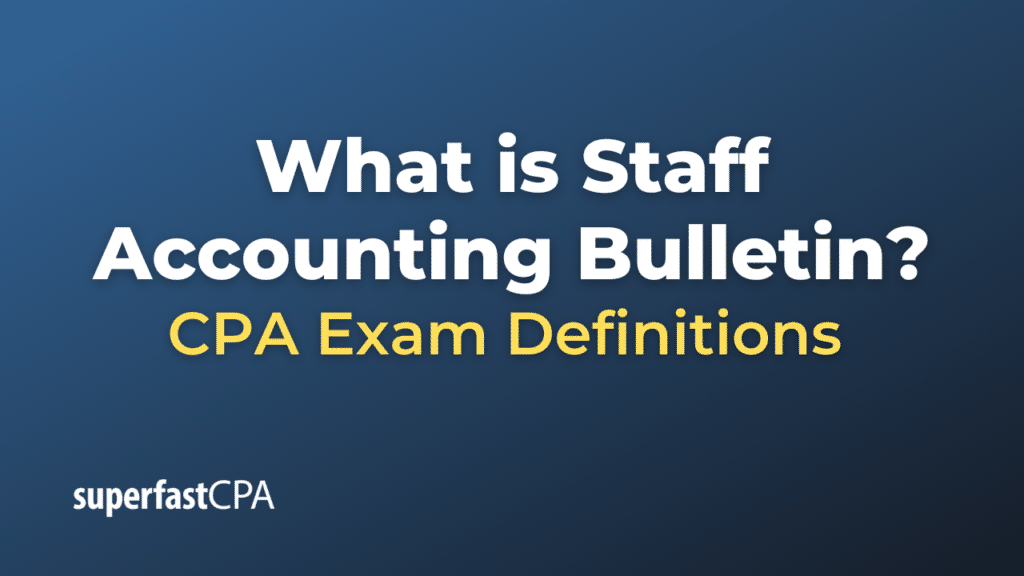Staff Accounting Bulletin
The Staff Accounting Bulletins (SABs) are interpretations and practices issued by the staff of the U.S. Securities and Exchange Commission (SEC). These bulletins represent the views of the SEC staff regarding accounting-related topics, and they provide guidance to the public on how the SEC staff interprets the application of current accounting rules and regulations.
While SABs are not official rules or regulations of the SEC, they do reflect the SEC staff’s views on certain accounting and financial reporting issues. Therefore, companies that are SEC registrants often look to these bulletins for insights and guidance on how specific accounting matters might be scrutinized by the SEC during reviews of their financial statements and filings.
The topics addressed in Staff Accounting Bulletins can range widely, from revenue recognition practices to disclosures about certain financial instruments. The objective is to address areas where the SEC staff has recognized diverse or potentially problematic accounting treatments, and to provide clarity or a preferred approach.
One of the most well-known SABs is SAB No. 104, which provides guidance on revenue recognition. While the implementation of the new revenue recognition standard (ASC Topic 606) has superseded much of the guidance in SAB 104, it remains an example of how the SEC staff has historically provided interpretive guidance on complex accounting topics.
For public companies in the U.S., staying informed about Staff Accounting Bulletins is essential to ensure compliance with SEC expectations and to reduce the risk of financial reporting and regulatory issues.
Example of Staff Accounting Bulletin
Let’s delve into a historical example to better understand the importance and application of Staff Accounting Bulletins (SABs).
SAB No. 99: Materiality
Background: One of the core principles in accounting is the concept of “Materiality.” Materiality refers to the significance of an item or error, such that its omission or misstatement might influence the economic decisions of users taken on the basis of the financial statements.
However, materiality is a subjective concept and can differ depending on circumstances and perspectives. Recognizing the potential for varied interpretations, the SEC staff issued SAB No. 99 to provide guidance on the assessment of materiality.
Key Points of SAB No. 99:
- Quantitative and Qualitative Factors: While certain numerical (quantitative) thresholds can serve as a preliminary basis for materiality, qualitative factors must also be considered. An item that might seem immaterial from a numeric perspective can be material if it, for example, hides an illegal transaction or changes a loss into income.
- Intentional Misstatements: SAB 99 notes that a small intentional misstatement could be more concerning than a larger unintentional error.
- Considerations of Registrant’s Size: A particular misstatement, such as a $1 million error, could be material for a smaller company but not for a large multinational corporation. However, this doesn’t mean that there’s a fixed percentage threshold that’s universally applicable.
- Cumulative Effects: The effects of several immaterial misstatements could be material when aggregated.
Implications: SAB No. 99 had implications for public companies’ internal control and financial reporting processes. For instance, companies couldn’t just rely on a predetermined percentage (like 5% of net income) as a de facto materiality threshold. They had to employ a more nuanced and comprehensive assessment.
Example Scenario:
Imagine a public company, GreenTech Inc., which discovered an error in its financial statements that led to an overstatement of revenues by $300,000. On the face of it, given the company’s net income of $50 million, the error might seem immaterial as it’s well below 1% of net income.
However, upon further investigation, it’s found that this error resulted from an intentional act by a senior manager, aiming to meet a specific earnings target which triggered a bonus payout. Even though the amount is numerically small in comparison to net income, given the intentional nature of the misstatement and its impact on the bonus structure, under the guidance of SAB No. 99, this error could be considered material.
This example illustrates how SABs, while not being formal SEC rules, offer valuable interpretive guidance on complex accounting and reporting issues.













